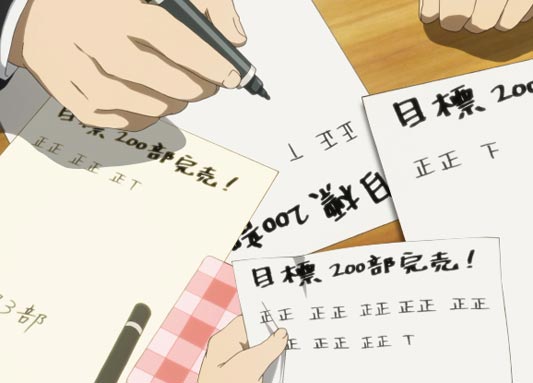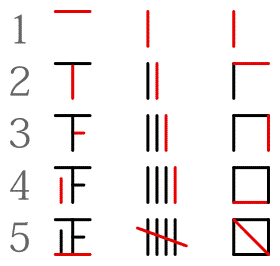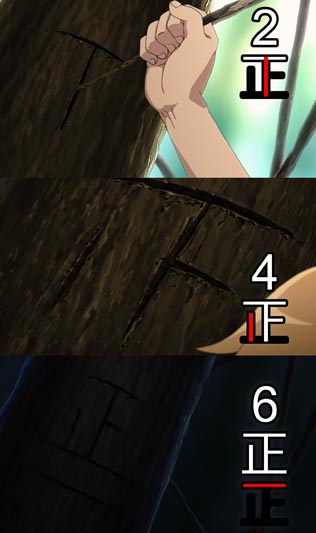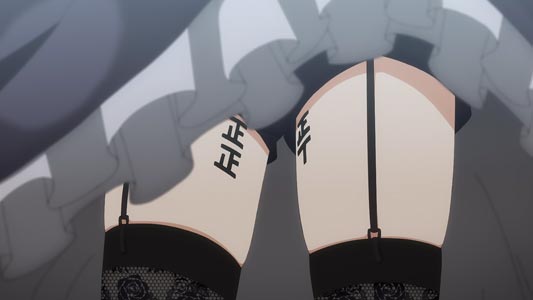In Japanese, 正, the kanji used in words like tadashii 正しい, "correct," "right," is sometimes used as a tally mark, for counting stuff, e.g. how many goals a team scored, how many days passed, etc., mainly because the kanji has five strokes, so every 正 written down means 5, e.g. 正正 means 10, or it could be part of a word like seisei-doudou 正正堂堂, "fair and square."
- Context: tally marks conserve energy because you don't need to erase them.
Stroke Order
Here's the correct stroke order of 正, and a comparison with other tally marks used elsewhere in the world:
- Context: tally marks created by humans, who have five fingers in each hand, which perhaps coincidentally only count up to five.
Beware that 2 looks like a T, so it may look like a character is writing something starting with "T" somewhere when they're actually counting stuff.
- Context: Rudeus Greyrat ルーデウス・グレイラット gets thrown into a prison cell in a forest, begins counting days in a very stereotypical way by carving tally marks on the tree (normally one would do this on a wall, but this cell has none).
- The images show 2, 4, and 6 days counted: T, 正 without bottom line, and 正 plus a single horizontal stroke under it.
Ironically, in manga and anime, it's generally unnecessary to know the stroke order: the tally marks merely convey that something is being counted at all, the more tally marks the higher the number counted. The exact number counted ends up not being very important most of the time.
Vertical or Horizontal
After counting to 5, you need to start a new tally mark, so you put it to the right to the first one, horizontally, or below the first one, vertically? It doesn't seem to matter.
It's true that Japanese text can be written horizontally or vertically, but the tally mark isn't really text, . it's a symbol drawn somewhere for counting, so the direction text is written is irrelevant.
That is, although the Japanese tally mark is based off a character that's used to spell words like seigi 正義, "justice," when 正 is used as a tally mark, it's no longer spelling words, so it doesn't need to be neatly aligned in lines, and you could place them diagonally if you wanted to.
Saying "Tally Mark" in Japanese
To refer to the tally mark itself you could say:
- sei no ji
正の字
The 'sei' character.- Because sei is one of the readings of the kanji
- sei no kanji
正の漢字
The 'sei' Chinese character. - sei no moji
正の文字
The 'sei' letter.
To refer to the method of counting with a tally mark:
On Thighs
A tally mark in hentai (drawn pornography) written on thighs or other body part may mean the number of times a girl has had sexual intercourse, e.g. in an orgy.
As this is a known trope, you may find tally marks written on thighs of characters with no obvious explanation about what they're supposed to mean. For example:
Anime: Sono Bisque Doll wa Koi wo Suru, その着せ替え人形は恋をする (Episode 5)
- Context: Marin cosplays as a character from an adult game. The tally marks are part of her cosplay.
Of course, they could be counting other things, but the insinuation is generally a lewd one.




This is like the only site where I can get answers to all these things I encounter in Japanese. Thanks to this article, I'm a little less confused now. Thanks :)
ReplyDeleteAre you sure the kanji stroke order is correct? Based on stroke order, its like 5 before 4.
ReplyDeleteWow, you're right. Which is weird, because I thought I had double checked this. Thanks for noticing, I've fixed the image now.
Delete